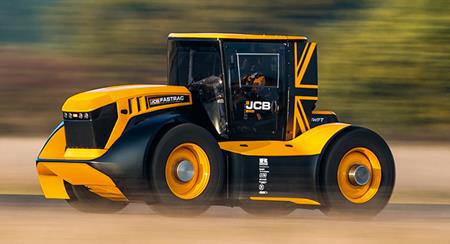The achievement comes after JCB set the British Record for the fastest modified tractor at Elvington Airfield near York in June 2019 in a tractor designated ‘Fastrac One’. It reached a speed of 103.6 mph with motorbike racer, lorry mechanic and TV personality Guy Martin in the driver’s seat. JCB then embarked on an ambitious plan to break its own record and developed ‘Fastrac Two’ – which was 10% lighter, more powerful and even more aerodynamic. Also driven by Martin, Fastrac Two hit a peak speed of 153.771mph on its way to clocking a record average of 135.191mph.
While engineering a JCB Fastrac agricultural tractor, normally weighing around 8.5 tonnes, to achieve speeds of over 100mph was something of an unusual challenge for Ricardo, it was not without precedent. Much of the same Ricardo team was responsible in 2006 for the development of the two 750hp engines and supporting systems of the JCB Dieselmax Land Speed Record car. The company has provided technology and assistance for a range of customers, from mainstream automotive and industrial to motorsport, who seek the ultimate in performance, emissions reduction and fuel economy.
Ricardo used cutting edge digitalisation methods to maximise performance, value and efficiency. These included using virtual reality (VR) for design reviews which enabled engineering teams across multiple sites to collaborate quickly and in real time, without having to travel extensively. In particular, creating a ‘virtual wind tunnel’ helped Ricardo, JCB and Williams engineers to collaborate remotely on aerodynamic optimisation.

This was further enabled by Ricardo’s suite of VR development tools. Ricardo VECTIS software was used to perform computational fluid dynamics (CFD) simulations of the external skin of the tractor. Further advanced software tools used included Ricardo’s IGNITE powertrain optimisation software and WAVE gas dynamics simulation package for air system development. Routinely used to optimise products for customers, these advanced software products enabled the Ricardo team to develop the JCB 7.2 litre, 6-cylinder engine to meet the power and torque targets for this project.
One way the engineers did this was by selecting a turbocharger that delivered a pressure ratio of ~5:1, while taking steps to improve the turbo lag that might otherwise be expected of such a large single-stage turbo. An electric supercharger, like those used on some production cars, helped get the tractor off the line. An air pulse system gave the turbocharger an extra ‘kick’ of energy to spool it up quickly as the vehicle accelerates through the gears – this was crucial in achieving high speeds over the comparatively short distance available on the runway.
The record-breaking performance of the Fastrac engine was achieved by incorporating technologies which are essential for low emissions, high fuel efficiency and high power-density engines. Advanced control, high-pressure common-rail fuel injection and advanced boosting (air pulse and electric supercharger) systems are instrumental in the very low level of emissions achieved by current and future production automotive and industrial engines.
“On behalf of Ricardo I would like to congratulate JCB, Guy Martin and the team on the fantastic achievement of the tractor world speed record,” said Stephen Dyke, MD of Ricardo Automotive & Industrial. “It was great to have a leading role in this project with the team at JCB and our fellow engineering partners. This was a tremendous effort, drawing on global best practice and technologies, and it delivered the ultimate in world-class performance.”





